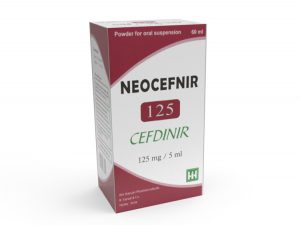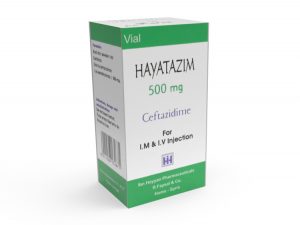استطباب: Cephalosporin Antibiotic
Packing :100 ml.
Form : Dry Suspension
Theraputic Categories : Pediatric Drugs
Indications : Cephalosporin Antibiotic
Composition :Cefdinir 250 mg./ 5 ml.
Packing :100 ml.
Form : Dry Suspension
Theraputic Categories : Pediatric Drugs
Indications : Cephalosporin Antibiotic
Composition :Cefdinir 125 mg./ 5 ml.
Packing :25 Vial
Form : Dry Vial
Theraputic Categories : Anti- infectives
Indications : Cephalosporin Antibiotic
Composition :Ceftazidime anhydrous 500 mg. / vial
Packing :1 Vial
Form : Dry Vial
Theraputic Categories : Anti- infectives
Indications : Cephalosporin Antibiotic
Composition :Ceftazidime anhydrous 1 g / vial
Packing :25 Vial
Form : Dry Vial
Theraputic Categories : Anti- infectives
Indications : Cephalosporin Antibiotic
Composition :Ceftazidime anhydrous 1 g / vial
Packing :1 Vial
Form : Dry Vial
Theraputic Categories : Anti- infectives
Indications : Cephalosporin Antibiotic
Composition :Ceftazidime anhydrous 2 g / vial
Packing :25 Vial
Form : Dry Vial
Theraputic Categories : Anti- infectives
Indications : Cephalosporin Antibiotic
Composition :Ceftazidime anhydrous 2 g / vial
Packing :1 Vial
Form : Dry Vial
Theraputic Categories : Anti- infectives
Indications : Cephalosporin Antibiotic
Composition :Ceftazidime anhydrous 6 g / vial
Packing :25 Vial
Form : Dry Vial
Theraputic Categories : Anti- infectives
Indications : Cephalosporin Antibiotic
Composition :Ceftazidime anhydrous 6 g / vial
Packing :10 cap.
Form : Capsules
Theraputic Categories : Anti- infectives
Indications : Cephalosporin Antibiotic
Composition :Cefixime (trihydrate ) 200 mg.
Packing :20 cap.
Form : Capsules
Theraputic Categories : Anti- infectives
Indications : Cephalosporin Antibiotic
Composition :Cefixime (trihydrate ) 200 mg.
Packing :6 cap.
Form : Capsules
Theraputic Categories : Anti- infectives
Indications : Cephalosporin Antibiotic
Composition :Cefixime (trihydrate ) 400 mg.
Packing :10 cap.
Form : Capsules
Theraputic Categories : Anti- infectives
Indications : Cephalosporin Antibiotic
Composition :Cefixime (trihydrate ) 400 mg.

Packing :60 ml.
Form : Dry Suspension
Theraputic Categories : Pediatric Drugs
Indications : Cephalosporin Antibiotic
Composition :Cefadroxil (monohydrate) 125 mg. / 5ml.
Composition:
Each Hayadraxil film coated tablet contains:
- Active ingredient: Cefadroxil (As monohydrate) 1000 mg.
- Inactive ingredient:
Core: microcrystalline cellulose, and magnesium stearate.
film: Hydroxypropyl methylcellulose (hypromellose),polyethylene glycol, polysorbate 80, and titanium dioxide.
Each Hayadraxil capsule contains:
- Active ingredient: Cefadroxil (as monohydrate) 500 mg.
- Inactive ingredient: Talc, Magnesium stearate.
Each 5 ml of suspension Hayadraxil Oral Suspension contains:
- Active ingredient: Cefadroxil (as monohydrate) 125mg or 250mg.
Inactive ingredient: Sugar, Sodium Starch Glycolate, Xanthan Gum, Colloidal anhydrous Silica, Sodium Benzoate, Citric Acid, Talc, Orange flavor, Orange Color (E110).
Pharmacological Properties:
Cefadroxil is a semisynthetic first-generation cephalosporin antibiotic for oral administration.
The bactericidal activity of cefadroxil results from inhibition of cell wall synthesis. Cefadroxil has been shown to be active against most strains of the following microorganisms, both in vitro and in clinical infections:
Beta-hemolytic streptococci, Staphylococci including penicillinase-producing strains, Streptococcus (Diplococcus) pneumoniae, Escherichia coli, Proteus mirabilis, Klebsiella species, Moraxella (Branhamella) catarrhalis.
Pharmacokinetics:
HAYADRAXIL is rapidly absorbed after oral administration. Following single doses of 500 mg and 1000 mg, average peak serum concentrations were approximately 16 and 28µg/ml respectively. Measurable levels were present 12 hours after administration. Over 90% of the drug is excreted unchanged in the urine within 24 hours. Peak urine concentrations are
approximately 1800 µg/ml during the period following a single 500-mg oral dose.
Indications:
Urinary tract infections
Skin and skin structure infections
Pharyngitis and/or tonsillitis
Contraindication :
HAYADRAXIL is contraindicated in patients with known allergy to the cephalosporin group of antibiotics.
Warnings and Precautions:
Before therapy with HAYADRAXIL is instituted, careful inquiry should be made to determine whether the patient has had previous hypersensitivity reactions to cefadroxil, cephalosporins, penicillins, or other drugs. If an allergic reaction to HAYADRAXIL occurs, discontinue the drug. serious acute hypersensitivity reactions may require treatment with epinephrine and other emergency measures.
Pseudomembranous colitis has been reported with nearly all antibacterial agents, including cefadroxil, and has ranged in severity from mild to life-threatening. Therefore, it is important to consider this diagnosis in patients who present with diarrhea subsequent to the administration of antibacterial agents.
Treatment with antibacterial agents alters the normal flora of the colon and may permit overgrowth of clostridia.
HAYADRAXIL should be used with caution in the presence of markedly impaired renal function (creatinine clearance rate of less than 50 mL/min).
Prolonged use of HAYADRAXIL may result in the overgrowth of nonsusceptible organisms. Careful observation of the patient is essential. If superinfection occurs during therapy, appropriate measures should be taken.
HAYADRAXIL should be prescribed with caution in individuals with history of gastrointestinal disease particularly colitis.
Positive direct Coombs’ tests have been reported during treatment with the cephalosporin antibiotics.
Use in Pregnancy:
- Pregnancy (Category B): This drug should be used during pregnancy only if clearly needed
- Nursing Mothers : Caution should be exercised when cefadroxil monohydrate is administered to a nursing mother.
Adverse Reactions:
Pseudomembranous colitis, Dyspepsia, nausea and vomiting, Diarrhea, Allergies (in the form of rash, urticaria, angioedema, and pruritus) , hepatic dysfunction, genital pruritus, genital moniliasis, vaginitis, moderate transient neutropenia, fever.
Agranulocytosis, thrombocytopenia, idiosyncratic hepatic failure, erythema multiforme, Stevens-Johnson syndrome, serum sickness, and arthralgia have been rarely reported.
Overdosage:
A study of children under six years of age suggested that ingestion of less than 250 mg/kg of cephalosporins is not associated with significant outcomes. No action is required other than general support and observation. For amounts greater than 250 mg/kg, induce gastric emptying.
Dosage and Administration:
HAYADRAXIL is acid-stable and may be administered orally without regard to meals. Administration with food may be helpful in diminishing potential gastrointestinal complaints occasionally associated with oral cephalosporin therapy.
- Adults:
Urinary Tract Infections: For uncomplicated lower urinary tract infections (i.e., cystitis) the usual dosage is 1 or 2 g per day in a single (q.d.) or divided doses (b.i.d.).
- For all other urinary tract infections the usual dosage is 2 g per day in divided doses (b.i.d.).
- Skin and Skin Structure Infections: the usual dosage is 1 g per day in single (q.d.) or divided doses (b.i.d.).
- Pharyngitis and Tonsillitis: 1 g per day in single (q.d.) or divided doses (b.i.d.) for 10 days.
- Children:
- For urinary tract infections, the recommended daily dosage for children is 30 mg/kg/day in divided doses every 12 hours.
- For pharyngitis, tonsillitis, and impetigo, the recommended daily dosage for children is 30 mg/kg/day in a single dose or in equally divided doses every 12 hours.
- For other skin and skin structure infections, the recommended daily dosage is 30 mg/kg/day in equally divided doses every 12 hours.
- In the treatment of beta-hemolytic streptococcal infections, a therapeutic dosage of HAYADRAXIL should be administered for at least 10 days.
| Child weight (kg) | 125mg/5ml | 250mg/5ml |
| 4.5
9.1 13.6 18.2 22.7 27.3 |
1tsp
2tsp 3tsp 4tsp 5tsp 6tsp |
–
1tsp 1.5 tsp 2tsp 2.5 tsp 3tsp |
- In patients with renal impairment, the dosage of cefadroxil monohydrate should be adjusted according to creatinine clearance rates to prevent drug accumulation. The following schedule is suggested. In adults, the initial dose is 1000 mg of HAYADRAXIL and the maintenance dose (based on the creatinine clearance rate is 500 mg at the time intervals listed below.
| Creatinin clearance dosage interval |
| 0-10ml/min 36 hr
10-25 ml/min 24hr 25-50 ml/min 12 hr |
- Patients with creatinine clearance rates over 50 mL/min may be treated as if they were patients having normal renal function.
Packing:
Tablets: Box contains 10 film coated tablets in PVDC/Al blisters
Capsules: Box contains 10-20 Capsules.
Oral suspension: Bottle contains 60ml or 100 ml.
Storage: Store at room temperature (15 – 30)°C.











